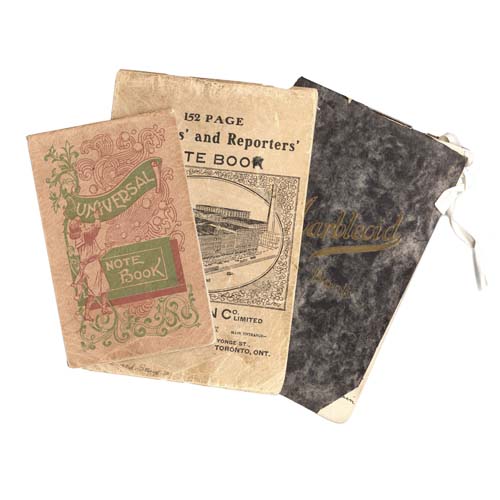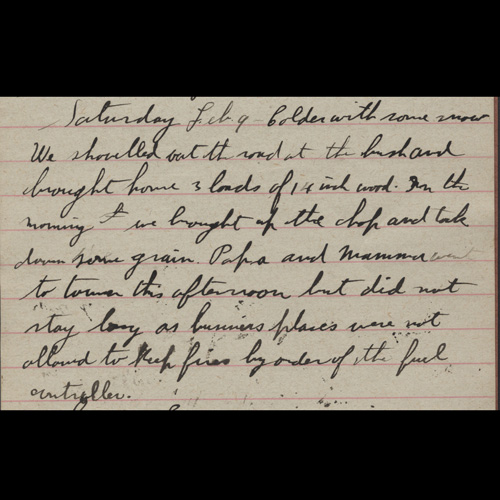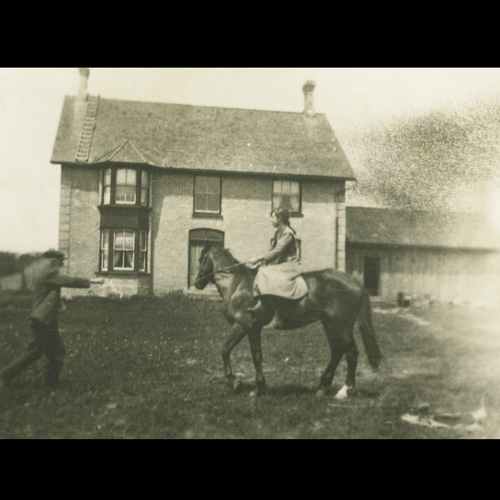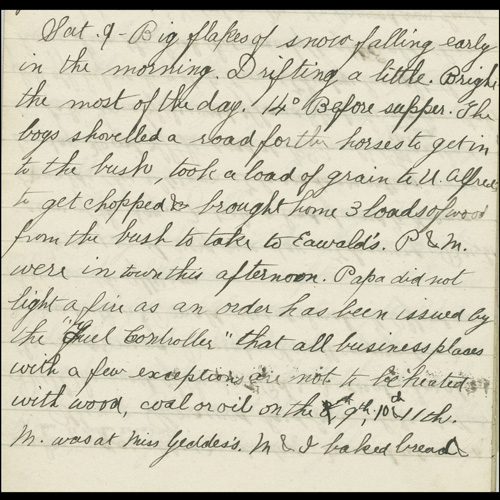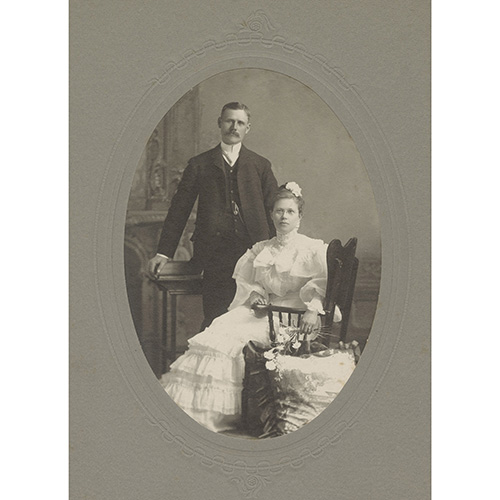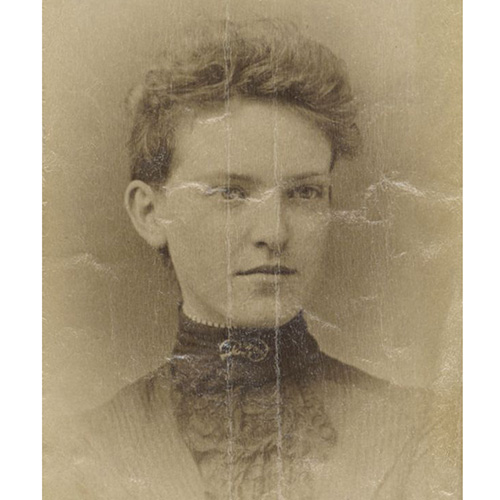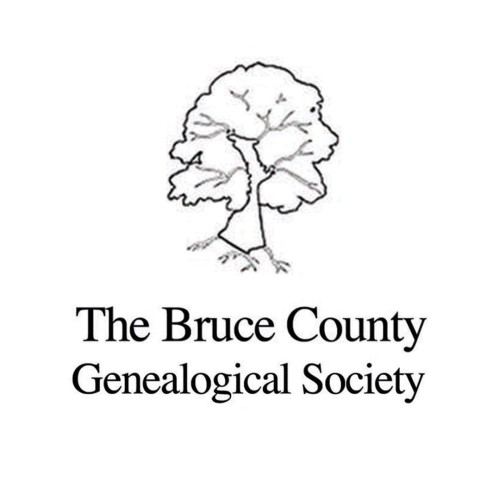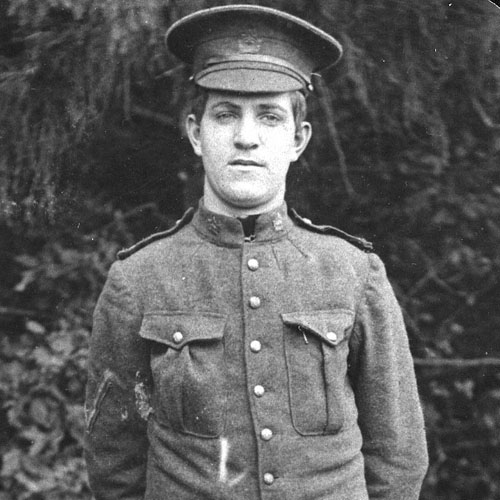Many of us can remember at least a few facts about some of the major events throughout history; but the little everyday moments that depict how people lived and spent their days also carry truths that can tell us much about the past.
In the Bruce County Museum & Cultural Centre Archives, we are pleased to have personal rural diaries from the nineteenth- and twentieth- century that allow us to peek into the daily social and work life of rural families and their neighborhoods over years past. They capture what life was like generations for those living in Bruce County towns, villages, and rural communities.
These diaries paint a picture of what it was like as a woman to run a homestead, with details about daily baking, mending, leaning stove pipes, churning, and washing. They talk of new technologies as they emerged to make life easier for rural residents, like the introduction of telephones and washing machines. And they recount the hardships and the backbreaking labour of working on the farm—clearing land, cutting wood, planting crops, harvesting, and raising livestock. Even simple details about the weather and its impact on accomplishing day-to-day tasks can often be found throughout these diaries.
Seen through a broader lens, these records reveal more than just the lives of those who authored them. They also document the lives and the activities of the many people that surrounded them, including their family members, friends, and other members of their communities.
Perhaps the most unique aspect of diaries as historical documents is that they capture a more personal side of history. They bring us closer to people of the past— how they felt, reacted, and overcame the events that shaped their lives. In these human emotions, we see ourselves reflected, and therein lies the immeasurable value of documenting and preserving time.
The following are examples of the experiences mentioned by diarists in the BCM&CC’s collection concerning disasters, social life, the role of women, living on the Home Front, early settlement, farm life, the rise of technology and community development, and the cost of living.
Disasters
We can find references to natural disasters and accidents in diaries. For example Elizabeth Oliver “Olive” Burgess (1896-1980, Arran Township, Bruce County) mentions the train derailment in May 1920 near Paisley: “Mailman did not come around today as the train got off the track near Paisley.”
She also writes about a small earthquake in March 1925: “There was an earthquake shock felt here on Sat. night. M. [Mamma] was sitting at the table & felt her chair shake & we saw the flowers shake on the 2 tables. In some houses the people never felt it & in some did & some didn’t. ”
We know that Bruce County residents became aware of the Titanic, within two days of its sinking. John Peirson (Saugeen Township, Bruce County) wrote about it: “April 17, 1912 – A terrible shipwreck on the Atlantic. Over a thousand drowned. … Commenced to plow.” James “Rowand” Burgess (1898-1968, Arran Township, Bruce County) made an entry in his diary that same day: “The Titanic struck and ice berg a couple of days ago and sank. Mr. C.M. Hayes was on board. It is not known who escaped and who did not.”
Social Life
Diaries reflect changing trends in social and leisure activities over the decades, as well as community events of interest.
When in their early twenties (in the 1910s), James and Olive Burgess mentioned some of their social activities: they attended Patriotic Picnics, School Box Socials, Literary Society meetings (including a debate on capital punishment), and a Leap Year Party at the Cheesemans. Olive wrote on February 4, 1916: “The boys were at the Literary society meeting…taking part in a debate “Eastern Canada is more preferable to live in than Western Canada”. Rowand was the leader…(and) proved that it was preferable to live in the Eastern part.”
The vote on the “Church Union” question, when the Methodist, Presbyterian, and Congregational Church members voted on uniting to form the United Church, seemed of particular interest to Olive Burgess. She notes that she voted on the “Church Union” question in Dunblane, and also mentions the vote at Port Elgin and Burgoyne churches in several entries in January 1925.
Mary Ann (Peirson) Hilborn (b. 1862, Saugeen Township, Bruce County) demonstrates some of the social and community activities of women in the 1920s, mentioning attendance at Women’s Institute and Missionary Society meetings (mentioning that organization’s 20th anniversary), as well as concerts at the Port Elgin Library and S.S. No. 7 Schoolhouse.
Francis Cooper (1918-1944, Kincardine Township, Bruce County) mentions going to the horse races in Kincardine, and attending choir practice and Kinlough church in the late 1930s.
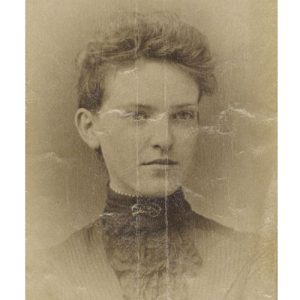
Kate Halliday Mickle (1871-1941, Chesley, Bruce County) had an active social life in Chesley. In the diary she wrote at 49 years of age (in 1920 – 1921), she mentions playing card games like solitaire and seven-up, tennis, canoeing, physical exercise, attending fairs, plays, and concerts, attending church, travelling with friends, calling on friends, afternoon teas, special suppers such as the Scottish Supper, and attending various movie showings at the Bijou theatre in Chesley, including “Haunting Shadows”. She also mentions some of the social activities of her husband (lawyer C.J. Mickle) including presentations to groups such as the Oddfellows, golfing, and tennis.
The Role of Women
During an era when it was expected that women would marry, Olive Burgess remained single. As a child-free woman she had a certain independence to pursue her interests, but she also cared for her siblings and aging parents and was caregiver, mentor, and guardian to other female relatives. Her family appreciated her important role, and she eventually inherited the co-ownership of the family farm.
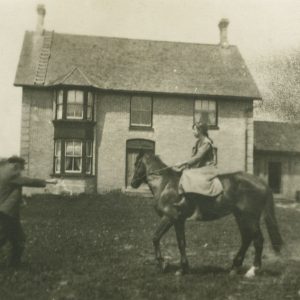
An excerpt from Olive’s diary, one busy Saturday morning, January 2h, 1918: “Bright and frosty cold wind. P [Papa] & R [Rowand] were in town. The roads were pretty heavy in the morning. N [Noble] was cleaning pig-pens & helping Edgar to try to chop but they did not get any done. M [Mamma] & I were baking pies & cakes & scrubbing & cleaning the stove. The Patriotic Society gave a concert last night at Burgoyne.”
Kate Halliday Mickle lived in Chesley and was a homemaker, mother, and writer with a very active social life. She wrote articles for the Chesley Enterprise and several plays, and busied herself with the Library Board and Horticultural Society. In between, she entertained a constant flow of visitors in her home. Her first diary in the BCM&CC Collection is about her wedding and honeymoon.
Excerpt from Kate’s diary June 20th 1893: “The most eventful day of my life I expect. The day upon which I was married. What I felt and what I thought I will not write here…” and then she tells of her honeymoon in Niagara Falls and their journey to New York where they visited a crematorium! Twenty-eight years later, in her 1920-1921 diary, she references reading, writing, literature and memory work, learning French, working on centre-pieces, as well as domestic activities of gardening, sewing, knitting, mending clothes, washing floors and dishes, grocery shopping, and picking up mail. Her husband and daughter are frequently mentioned. Her January 19, 1921 entry gives an example of additional community involvement: “Writing secretaries report for congregational meeting.”
Life on the Home Front
Diaries written during periods of military conflict can give insight into the extent to which the conflict impacted the daily lives of Bruce County residents. Rowand Burgess mentions on February 9, 1918 that there were no fires for heat in stores in Port Elgin by order of the Fuel Controller. His sibling Olive mentions Red Cross Society fundraising events in 2016. Francis Cooper mentions going to a dances in Pinkerton, Bervie, Armow, Kingarf, and Glamis hosted “by the Red Cross” (Dec. 1, 1939). He mentions going to town “to see about the Perth Regiment” in January 1941, and did enlist in June that year. He died during his military service in 1944.
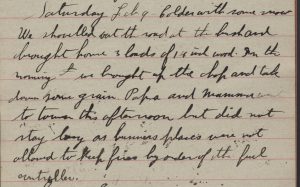
Early Settlement
Nathaniel Edward Leeder Sr. (1835-1923, Saugeen Township, Bruce County) was one of Saugeen Township’s earliest pioneers, settling here in 1854. At the end of his long days clearing land, burning brush, planting and harvesting, raising barns, and helping neighbours, he sat down by candlelight in his cabin and recorded the day’s happenings and his business dealings. His dairies provide interesting insight into life as it was lived in this area 170 years ago as the pioneers strived to supply themselves with shelter, food, and community.
There were no schools in the area at the time of early settlement and Leeder notes his attendance at school meetings to discuss establishing a school in the area. There are many references to purchasing whitefish and trout from a neighbour down the road, implying that fish was an important part of pioneers’ diets, particularly until they were able to purchase and raise other forms of meat. His diary reveals challenges of tasks that we would consider simple today; for instance, the could procure flour after harvesting wheat. They would load it in a small boat and take it to a mill sometimes as far away as Port Albert (near Goderich), a task that sometimes took many days. “Started for mill in boat with grist in company of J. Goble, Robert Craig and James Stuart. Forced to take it to Port Albert, all the mills this side of it being short of water.” (Leeder diary, June 14, 1854)
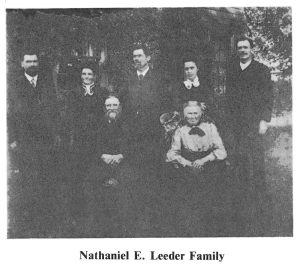
Beyond agricultural chores and dealings, some of the other activities noted in Leeder’s diary include:
• Father started to Kincardine to the mill to work. Started about half past three in the morning (December 21, 1854
• Volunteered to serve in the Militia (December 30, 1862)
• Raising barn. … I had 23 hands (July 3, 1855)
• Township show entered. … Took second prize for fall wheat, first prize for onions, fourth prize for butter and first prize for carrots. Sold Henry Hilker 210 bushels of fall wheat to be as good as that shown at the show and delivered in two weeks from this date.
Farm Life
The diaries of Olive and Rowand Burgess are examples of diaries that enable us to envision rural life in Bruce County in the early 20th century. Their entries mention all manner of work on the farm related to cutting lumber, growing crops such as oats, barley, beans, mangels, turnips, peas, and wheat, and raising livestock such as hens, pigs, and cattle. It’s estimated that men spent nearly 17% percent of their workdays harvesting wood for fuel. Rowand and his brother Noble spent many days hauling logs from the bush, sawing and chopping them for use on the farm and for sale in town. On February 20, 1918, it was minus 11 degrees Fahrenheit with high winds. Rowand wrote in his diary: “Arthur helped us to kill a pig in the morning. In the afternoon we cut wood. Noble got his nose frozen and I got my nose frozen and my cheek badly frozen.”
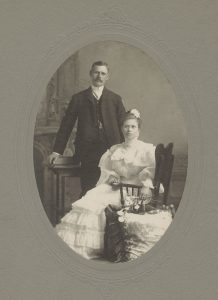
The farm of William Henry Arkell (1870-1955, Culross Township, Bruce County) is known for its Cotswold sheep and Berkshire pigs. A reader can see him build his reputation as a breeder and his role amidst the best farmers in the area. He writes in his diary:
- 1908 October “6 This is the first day of Teeswater show, I have been in town all day helping in the Hall. 7 We were all at Teeswater show, It was the best show we ever had the gate recpts were $417.05.“
- 1908 October “16 Geo finished ploughing field and started to pick appels. I took morning train to Guelph to buy ram from Henry Arkell came home evening train, bought imp shearling ram, 1st prize ram at Toronto.”
- 1908 November “30 A busy day away from the farm: “Walter + I took two fat cows to Mildmay this morning. It has been raining nearly all day. This afternoon I attended F I {Farmer’s Institute} meetings in Belmore took tea at Shielfield & came home sick. Thunder this afternoon.”
Rise of Technology and Community Development
The diaries in BCM&CC’s collection mention installation or purchase of agricultural equipment and communication and other equipment. James Burgess, for example, mentions the installation of a cream separator in 1916. His sister mentions the installation pipe organs in the Burgoyne and Port Elgin Presbyterian Churches in 1915. In 1917, she refers the acquisition of gravity washing-machine and Empire cream separator January 2, 1917. The installation of a Bell Telephone is mentioned at least twice by Olive: at the Geddes home in 1917 and at her Uncle Alfred’s in 1918. These kinds of references remind us that there was a time when people lived without these modern conveniences and support our imaginations as we consider what it would have been like to go about our days during that time period.
Cost of Living
Information revealed in diaries about the price of goods and services are interesting to those reflecting on inflation. These are just a few references to the cost of goods in the BCM&CC collection of diaries:
• $0.10 / lb for beef (1924, Olive Burgess diary)
• $1.50 for two teeth fillings by the dentist (1916, Rowand Burgess diary)
• $2.30, for two chickens (1921, John Pierson diary)
• $3 for a pair of boots (1854, Nathaniel E. Leeder diary)
• $14 for cooking stove (1859, Nathaniel E. Leeder diary
• $120 to build a barn “not to be surpassed in Saugeen” (1862, Nathaniel E. Leeder diary)
Diaries in the BCM&CC Collection
Diaries are an extremely valuable resource providing first-hand accounts of daily living and community development over past decades throughout the County.
To view descriptions, transcripts (when available), and digitized copies (when available) of the diaries in BCM&CC’s Collection, visit BCM&CC’s Online Collections.
Links to diary descriptions (and images/transcripts when available) mentioned in this article:
- Arkell family (William and Elizabeth Arkell), Culross Township, 1908-1915, 1930-1938
- Cecil Swale, 1904
- Elizabeth Oliver Burgess, Arran Township, 1915-1918, 1920, 1924-1926, 1966-1972, 1974
- Francis Cooper, Kincardine, 1937-1942
- James Rowand Burgess, Arran Township, 1911 – 1918, 1929-1936, 1950-1968
- John Pierson and family, Saugeen Township, 1888, 1892-1919, 1921-1925, 1927
- Kate (Halliday) Mickle, Chesley, 1893, 1920-1924, 1926-1928, 1932, 1934
- Nathaniel Leeder Sr., Saugeen Township, 1854-1951
Diary Digitization
As of the writing of this article in March 2024, over 2,800 pages of diaries (including personal rural diaries and military diaries) have been digitized and are available for online viewing through the links above. This is thanks to BCM&C’s dedicated volunteers and staff. As time and resources allow, digitization of diaries will continue over the next couple of years.
Many of the rural diaries are being shared with University of Guelph’s Rural Diary Archive, whose volunteers are assisting in creating and sharing typed transcriptions of the diaries. When these transcriptions become available, download links will also be added to the diary descriptions linked above.
Diary Donations
If you have a collection of you ancestor’s diaries (written while residing in Bruce County) and would like to donate them to the BCM&CC to make them available to researchers and those with an interest in understanding more about life in years past, please contact the Bruce County Archives at the Bruce County Museum & Cultural Centre:
- archives@brucecounty.on.ca
- Research Room Direct Line: 226-909-2426.
We’re all part of history-in-the-making!

